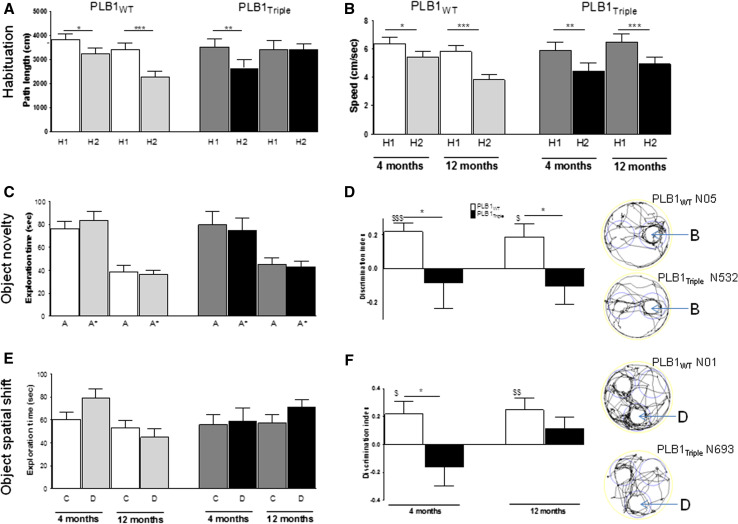Fig. 8.
Performance of PLB1WT and PLB1Triple mice in two object recognition tasks. a Overall locomotor activity during habituation session H1 and H2: Activity was lower in H2 than H1 for all cohorts except PLB1Triple mice aged 12 months. b Ambulatory velocity was different between H1 and H2 at all age groups, but not related to factor phenotype. c Novel object recognition—sample phase: independent of genotype, animals spent equal amounts of time with objects A and A*. Note the age-related reduction in object exploration to about 50 % in 12 month old subjects. This was independent of genotype. d Novel object recognition—test phase: Object A* was replaced by object B. Discrimination index confirms that while PLB1WT mice prefer object B (positive index), PLB1Triple mice clearly did not (asterisks)—there was a small bias for the familiar object. e Object recognition, spatial shift sample phase: exploration was equal for objects C and D independent of age and genotype. f Object recognition, spatial shift test phase: Object D was shifted to a novel location. Discrimination index confirms that while PLB1WT mice prefer object D (positive index), PLB1Triple mice clearly did not (asterisk). The positive index of PLB1Triple mice at 12 months of age was due to two subjects. Note that index is not different from chance (0). All data are presented as mean ± SEM. *p < 0.05; **p < 0.01; ***p < 0.001 between genotype (t test). $ p < 0.05, $$ p < 0.01, $$$ p < 0.001 relative to chance. Tracks of representative animals aged 4 months undertaking object novelty test (top) and spatial shift (bottom) are also indicated. Circles indicate in-object zones, in which tracking was recorded as exploration. B novel object, D shifted object

